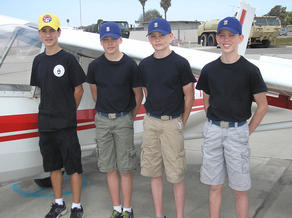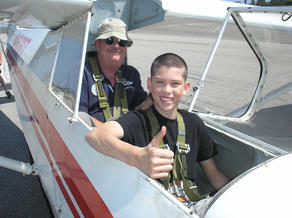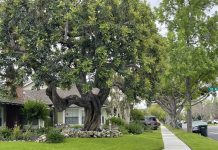
Soaring through the blue yonder are the Civil Air Patrol (CAP), Squadron 153, cadets who recently had glider practice at the Army Airfield at the Joint Forces Training Base in Los Alamitos. On a beautiful sunny clear day, a few cadets were able to sail high into the skies while learning, leading and serving in the Air Force Auxiliary.
Glider planes are launched by a manned motorized wench while attached to a special plastic line, 5,000 feet down the runway. Once a radio command is given, the glider is launched at about 50 to 60 miles per hour to a height of 1,200 to 1,500 feet, following the flight pattern around the airfield, making a few turns in the process, then landing smoothly at the same spot every time on the runway.
Glider practice at the JFTB has been going on in Los Alamitos since 1972. Cadets ride in a two-seated glider with flight instructors, flying every Tuesday from 4 p.m. to dark and on Sunday from 10 a.m. to 4 p.m. Squadron 153 meets every Wednesday at 7:30 p.m., at the JFTB. CAP members volunteer to train cadets. “The only way aviation goes on is in training young people,” said CAP Capt. John Chapman, who rides with cadets on glider flights along with Lt. Col. Dave Widrig.
“This is all about taking the dream (to fly) to the ‘I can do it level,’” said Chapman. “You have to start with a dream. What we do is give them a little bit of the opportunity and guide them in the right direction.”
Youth ages 12 up to 19-years-old can obtain five hours of glider and powered flight time, being eligible to solo in gliders by the age of 14, and earning an airman certificate by age 16 or 17. Each cadet gets 10 free rides as part of CAP’s aerospace education, according to CAP Deputy Commander James Welliver.
“The primary goal is leadership training and aerospace education,” said Welliver. “They are allowed to earn certificates in glider and airplane flying, allowing cadets to actually get a hold of the controls. Cadets are also trained in emergency preparedness and as first responders.”
The Air Force Auxillary Civil Air Patrol has been around since 1941 and was founded by more than 150,000 citizens concerned about the defense of America’s coastlines. In 1946, President Harry Truman established the entity as a federally chartered non-profit, and in 1948, the CAP was designated as the Air Force Auxillary with three primary missions – emergency services, cadet programs and aerospace education. In 1969, Squadron 153 was chartered.
Cadet life includes flying, leadership training, obstacle courses, model rocketry, team building, camping and hiking, search and rescue, earning ranks and awards, and exploring aviation careers. “Cadets first learn to follow, learn to teach and lead, and how to plan the program to organize it at the executive level,” said Welliver. “They do this by essentially working with each other, but are supervised all the way.”
Cadet Donald Marion, 13, of Fountain Valley said there is nothing you can’t dislike about the CAP. He eventually wants to go to the Air Force Academy and join the Air Force. “If anyone wants to join the military or fly commercial airplanes, the CAP is the place to be,” he said. Marion said he’s being prepared with leadership, discipline and respect for others.
“It’s fantastic,” said Selena Marion, Donald’s mother. “They teach them all about military etiquette, and they attend a boot camp yearly. Donald also volunteered in optional community service for military awards for more than 10 hours a week, and learned about responsibility in a working environment.”
“The whole program is about their motto, ‘trained to lead,’” said Donald’s father, Don. “Kids are taught to follow and respect authority, to take responsibility and to lead.” He continued that the cadets are responsible for such things like paperwork, promotions, uniforms and boots.
Other cadets earning glider flight time were triplets, Tibor, Tyler and Trent Francia, 13, of Long Beach who have been with Squadron 153 for about a year now. Tibor and Tyler want to be Air Force pilots while Trent wants to be a commercial pilot. Looks like all the cadets are well on their way towards accomplishing their dreams.
For more general information on the CAP, please visit online to gocap.gov or Google online “California Wing Civil Air Patrol.” To find out more information on Squadron 153, please Google “Los Alamitos Cadet Squadron 153.”












